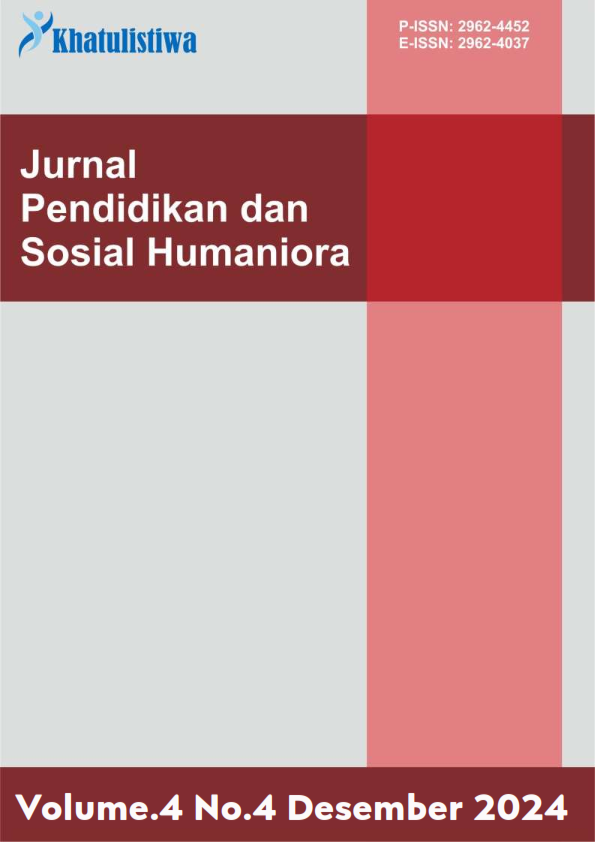Meningkatkan Minat dan Hasil Belajar Kelistrikan Bodi dengan Model Pembelajaran Project Based Learning di Sekolah Menengah Kejuruan
DOI:
https://doi.org/10.55606/khatulistiwa.v4i4.8743Keywords:
interests, learning outcomes, PjBL, Project Based Learning, SMK Taman Karya MadyaAbstract
Vocational education in Indonesia plays a crucial role in improving the quality of a skilled workforce ready to face the challenges of the industrial world. One vocational field that receives special attention is the Light Vehicle Engineering (TKR) study program, where body electrical engineering is one of the main subjects taught. Body electrical engineering is a crucial aspect of vehicle maintenance and repair, where a thorough understanding of electrical engineering is essential for operating and repairing electrical systems within vehicles. However, in practice, obstacles are often encountered in the process of learning body electrical engineering, particularly in terms of student interest and learning outcomes. Many students feel a lack of interest in this subject, which causes them to not optimally absorb the material. One way to address this problem is to implement a learning model that can foster interest in learning and improve student learning outcomes. One such model is Project-Based Learning (PjBL). PjBL is a learning model that prioritizes active student involvement in completing real-life projects relevant to the material being studied. Through this model, students are expected to learn in a more applicable and enjoyable way, which in turn can improve their understanding and learning outcomes. This study aims to test the effectiveness of the PjBL learning model in increasing the interest and learning outcomes of electrical engineering of class XI students at SMK Taman Karya Madya Pertambangan Kebumen.
References
Adha, L. A. (2020). Digitalisasi industri dan pengaruhnya terhadap ketenagakerjaan dan hubungan kerja di Indonesia. Jurnal Kompilasi Hukum, 5(2), 267-298. https://doi.org/10.29303/jkh.v5i2.49
Fathurrohman, M. (2016). Model-model pembelajaran inovatif. Yogyakarta: Ar-Ruzz Media.
Jatmoko, D., Haryadi, A., Susanto, A., & Listiana, M. R. (2025). Development of learning media system video animation material of motorcycle battery charging system for automotive students of UM Purworejo. Jurnal E-Komtek, 9(1), 359-369. https://doi.org/10.37339/e-komtek.v9i1.2423
Jatmoko, D., Primartadi, A., Purwanto, J., & Sulistyowati, W. (2023). Penilaian keberhasilan pelaksanaan praktik industri dilihat dari pengaruh motivasi belajar dan metode pembelajaran daring (dalam jaringan) di SMK Dirgahayu Kedungadem. Jurnal Pendidikan Sang Surya, 9(1), 138-143. https://doi.org/10.56959/jpss.v9i1.103
Jatmoko, D., Suyitno, S., Rasul, M. S., Nurtanto, M., Kholifah, N., Masek, A., & Nur, H. R. (2023). The factors influencing digital literacy practice in vocational education: A structural equation modeling approach. European Journal of Educational Research, 12(2), 1109-1121. https://doi.org/10.12973/eu-jer.12.2.1109
Murtadho, F., Boeriswati, E., & Parai, H. (2023). Pengembangan kurikulum. Penerbit Adab.
Nurhidayanti, R. I. S. M. A. (2023). Implementasi pembelajaran pendidikan agama Islam berbasis kurikulum merdeka di SMKN 3 Jember tahun pelajaran 2022/2023 (Doctoral dissertation, UIN KH Achmad Siddiq Jember).
Rahmatillah, W., Jayatri, T., Isnata, R., Wulandari, S., & Siltawani, A. (2025). Penerapan model PjBL terhadap keaktifan belajar siswa mata pelajaran IPAS kelas 6 SDN 60 Kota Jambi. Jurnal Kompetensi Guru Indonesia, 1(1), 15-21.
Saefuddin, & Berdiati, I. (2014). Pembelajaran efektif. Bandung: PT Remaja Rosdakarya.
Sanga, L. D., & Wangdra, Y. (2023, September). Pendidikan adalah faktor penentu daya saing bangsa. In Prosiding Seminar Nasional Ilmu Sosial dan Teknologi (SNISTEK) (Vol. 5, pp. 84-90). https://doi.org/10.33884/psnistek.v5i.8067
Subyantoro. (2009). Penelitian tindakan kelas (Edisi revisi). Semarang: Undip Press.
Sudjimat, D. A., Nyoto, A., & Romlie, M. (2021). Interdisciplinary project-based learning. Media Nusa Creative (MNC Publishing).
Surya, Y. F. (2017). Penerapan model pembelajaran problem based learning untuk meningkatkan hasil belajar matematika siswa kelas IV SDN 016 Langgini Kabupaten Kampar. Jurnal Cendekia, 1(1), 38-53. https://doi.org/10.24114/js.v1i2.7315
Thahir, M., Widiawati, M. P., & Wahyuni Thahir, S. S. (2024). Perencanaan pendidikan: Upaya membangun modal manusia unggul. Indonesia Emas Group.
Wardoyo, S. (2018). Desain pengembangan fasilitas sekolah di era revolusi industri 4.0.
Widiansyah, A. (2017). Peran ekonomi dalam pendidikan dan pendidikan dalam pembangunan ekonomi. Cakrawala: Jurnal Humaniora, 17(2), 207-215.
Downloads
Published
How to Cite
Issue
Section
License
Copyright (c) 2024 Khatulistiwa: Jurnal Pendidikan dan Sosial Humaniora

This work is licensed under a Creative Commons Attribution-ShareAlike 4.0 International License.








